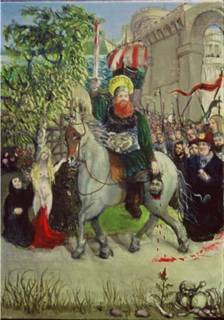
Victorious March of Erik of Northumberland With Head of Phillip the Unpleasant
Unknown Master of Ballard, Aprox 1312-1327
12" by 9", oil on board. Collection of The Hermitage Annex, Port Angeles, Washington.
Little is known of either Erik of Northumberland or the events depicted by the unknown Master of Ballard in this work, but it is commonly assumed by historians that this event, reputedly near the ancient fortress of Caerphilly in Wales, may have been an inspiration for The Groesome and Bluddy Deth of Wankeroose Philip and hir Daeposement, a famous late 14th morality play by Franciscan scribe Llllaycloophulllaiem of Cardiff, depicting the defeat of an infamous Welsh tyrant and moneylender by an equally brutal but welcomed invader of Viking descent named Irik or Errik of Angleterre in certain fragamentary Icelandic sagas, such as Irik, Lawgiver of Blood. It's best known surviving sentence is translated:
To Irik Gave Vortol the Weregild in Obescience, a Chest of Silver and Entrails
But Irik Held His Fast His Countenance, and Made a Rich Soup
This Errik was known for his famous bear faced armor and, as can be seen, was one for the ladies. His famous "grat ruddy hooge fuk-off beird" was the subject of a nearly lost Scottish ribald song, for the lute and now-forgotten Grendel pipes, whose drones reached nearly 2o feet, which told the story of Errik's supposed wooing of Violet Platagenet, the "Fair Loos Princess" of York, and the loss of the key to her Chastity Belt in the aforementioned beard.
The Master of Ballard here foreshadows the renaissance with an inconsistent application of perspective which was actually known to Roman painters. He depicts Erik in his traditional green and bear armor, and shows the supplication of monks, and the entreaty of important local merchants such as Michael of Normandy, an important fish-monger and pornography trader, for favor. A small fraction of his 1000 ship-bourne pikers follows at the right.
A large bear, clearly a pagan symbol important to the half-Christianised Erik, is shown gently sitting next to the young nude woman, and a rose bush seems to celebrate Northern of England. The pile of human remains in the foreground probably symbolizes Phillip's habit of quartering peasants for putting human waste in his tributary corn, a tradition of rather crude practical jokes which began early in his reign after Phillip harrangued peasants for dancing and carrying on after eventide; this remote Welsh community may have in fact originated the first putting of manure in a bag and lighting it on fire before knocking loudly and running away.


3 Comments:
Hmmm. Obviously the most talented of artists, and strangely, Erik of Northumberland bears a striking resemblance to the Viceroy's great grandmother.
Some knowledgable art historians working with X-rays have rejected the " VanWyck VanDyck" or "Van De Wyck De Dick De VanWyck) conjecture - a curious instance when the forger attempted to claim credit for an original several hundred years older by adding a clog and mushrooms in the boat, which covers, as it turns out, a chastity belt and a lockpick.
Some knowledgable art historians working with X-rays have rejected the " VanWyck VanDyck" or "Van De Wyck De Dick De VanWyck) conjecture - a curious instance when the forger attempted to claim credit for an original several hundred years older by adding a clog and mushrooms in the boat, which covers, as it turns out, a chastity belt and a lockpick.
Post a Comment
<< Home